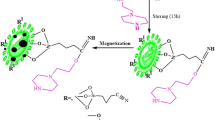Abstract
In this paper the spore-crystal complex of Bacillus thuringiensis var. israelensis (Bti) was immobilized by the sol-gel process in a hybrid polymer using as precursors the inorganic tetraethyl orthosilicate (TEOS) and the organic Polydimethylsiloxane (PDMS); in order to combine the advantages of both materials in a hybrid matrix to improve aspects such as the thermal stability, the hydrophobic properties and the porosity. Bti produces different crystals during sporulation phase; these are of protein nature and are used as bio-insecticides. It is important to mention that the insecticide attack is specific to the mosquito larva that causes dengue and black flies. The samples were characterized to ensure viability by performing growth kinetics with fermentations immersed in a flask, this microbial growth was monitored by dry weight, glucose consumption and characterized by Fourier Transform Infrared Spectroscopy (FTIR) to observe the interaction of materials with spore-crystal complex.
Similar content being viewed by others
References
Prabakaran G., Hoti S. L., J. of microbiological methods. 72, 1 (2008).
Soares Cleide M.F., Onélia. dos Santos, Heizir F. de Castro, Flavio F. de Moraes, and Gisella M. Zanin, J. of Molecular Catalysis B: Enzymatic. 39, 1–4 (2006).
Manonmani A.M., Hoti S.L., Trop. Biomed. 12, (1995).
Wirth M.C., Delecluse A., Federici A.B.A., Walton W.E., Appl. Environ. Microbiol. 64, (1998).
Y. Shchipunov, T. Y. Karpenko, I. Y. Bakunina, Y. V. Burtseva, and T. N. Zvyagintseva, J. Biochem. Biophys. Methods. 58, 1 (2004).
Soares C. M. F., dos Santos O. A., de Castro H. F., de Moraes F. F., Zanin G. M., J. of Molecular Catalysis B: Enzymatic. 39, 1–4 (2006).
C.J. Brinker and G.W. Scherer, Sol–Gel Science: “The Physics and Chemistry of the Sol–Gel Processing”, Academic, San Diego, CA, USA (1990).
K. Chakrabarti, S. M. Kim, E. O. Oh, and C. M. Whang. Materials Letters. 57, (2002).
Méndez-Vivar J., Mendoza-Serna R., Valdez-Castro L., Journal of Non-Crystalline Solids. 288, 1–3 (2001).
Mosquera M. J., de los Santos D. M., Montes A., Valdez-Castro L., New nanomaterials for consolidating stone. Langmuir. 24, 6 (2008).
Toledo Fernández J. A., Mendoza-Serna R., Santos A., Piñero M., Rosa-Fox N. D. L., Esquivias L., J. Sol-Gel Sci. Technol, 45, 3 (2008).
Byler D. M., Susi H., Biopolymers. 25, 3 (1986).
Acknowledgments
The authors thank the “Programa Integral de Fortalecimiento Institucional, (PIFI)” for the funding provided to the present project.
Author information
Authors and Affiliations
Rights and permissions
About this article
Cite this article
Valdez-Castro, L., Méndez-Amaro, L., Mendoza-Serna, R. et al. Organic-inorganic materials to immobilize biological complexes. MRS Online Proceedings Library 1480, 33–38 (2012). https://doi.org/10.1557/opl.2012.1615
Published:
Issue Date:
DOI: https://doi.org/10.1557/opl.2012.1615




